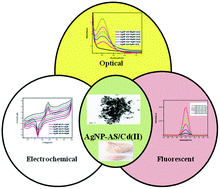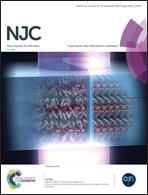Green silver nanoparticles as a multifunctional sensor for toxic Cd(ii) ions
Abstract
A highly sensitive and selective technique was developed for the detection of Cd(II) ions using green synthesized silver nanoparticles (AgNPs) from Allium sativum (AS) extract without any surface functionalization. The synthesized AgNP-AS was characterized by various analytical techniques. The aggregation of Cd(II) ions with AgNP-AS produces a color change from brown to golden yellow. The Cd(II) ion aggregation with AgNP-AS was studied by UV-vis spectroscopy, fluorescence spectroscopy, and electrochemical techniques. The limit of detection of the system was calculated by differential pulse voltammetry (DPV) and it was found to be 0.277 μM. The synthesized AgNP-AS shows high selectivity towards Cd(II) ions compared with various metal ions such as Ni(II), Cu(II), Zn(II), Cr(III), Fe(II), Pb(II), Co(II) and Hg(II) ions. Furthermore, AgNP-AS was applied for the sensing of Cd(II) ions in real samples collected from a lake, pigment, cosmetic product, and fertilizer industries. The synthesized AgNP-AS also exhibited antibacterial properties against waterborne bacteria like Escherichia coli and Staphylococcus aureus extracted from the lake water sample collected from the Ashtamudi lake, Kollam, Kerala.



 Please wait while we load your content...
Please wait while we load your content...